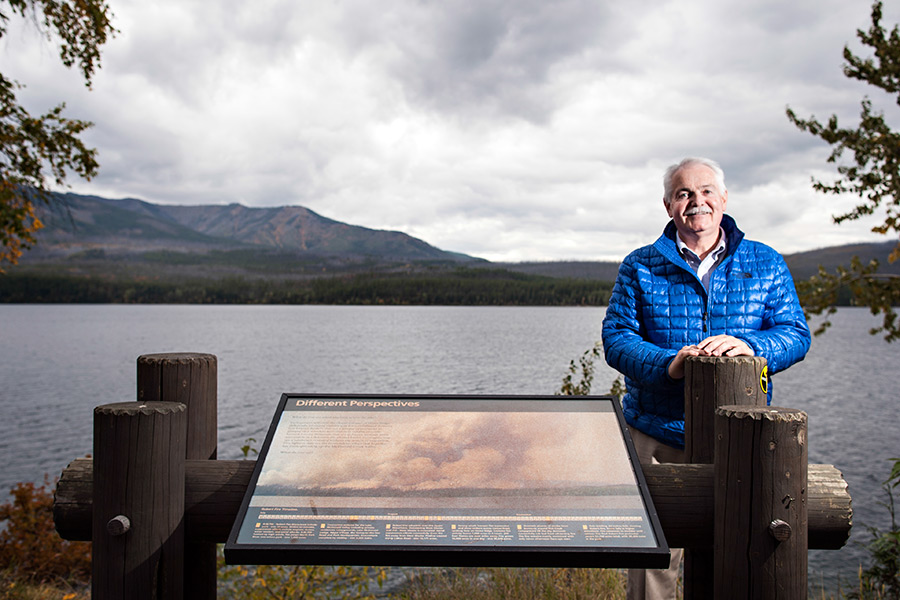WEST GLACIER – Sitting behind a computer and sporting a light blue button-down shirt and khaki pants, Bill Hayden doesn’t look like his coworkers at Glacier National Park, with their dark canvas uniforms and flat-brim hats.
But Hayden’s assignment isn’t like many of their jobs either. He’s not crossing rivers to rescue stranded hikers or leading tours about berries and bears. His job is away from public view. Yet anyone who has ventured into Glacier’s 1 million square acres has certainly seen Hayden’s work.
From a small office at park headquarters in West Glacier, Hayden creates all of the signs and interpretive wayside exhibits inside the park. The signs can be found at about 130 locations from East Glacier Park to Polebridge.
Hayden, who is acting chief of interpretation, was recognized recently for his work on a display at Logan Pass that earned a third-place award from the National Association of Interpretation.
“Wayside exhibits are super helpful to visitors because it helps them connect with the resources,” Hayden said.
Hayden also produces the park’s publications and brochures, runs its social media accounts, including Facebook, Twitter and Instagram, and its website.
Although Hayden spends most of his days designing interpretive signs and running social media accounts, he doesn’t have a degree in marketing, design or communications. Hayden studied biology at Washington State University and landed his first job with the National Park Service in 1980. In the mid-1980s he was working at Grand Teton National Park when one of his co-workers purchased one of the first Apple computers. Hayden was initially uninterested in the machine, but he soon began using it to draw pictures and create interpretive pamphlets for the park.
In 1990, Hayden got a job in Many Glacier as an interpretation supervisor in the summer. During the winter he would stay on the west side of the park and work on media projects and publications, including the ranger-led activities pamphlets and park newsletters that are published every month in the summer.
The media work eventually led to a fulltime job. Among his duties was working with National Park Service designers in Harpers Ferry, West Virginia to make wayside signs. Back then it would take up to 18-months to finish a sign and would cost about $3,000.
That all changed in 2003 when fires ravaged the park, burning more than 136,000 acres in July, August and September. Hayden and others realized that the 18-month timeline it took to make signs would not work.
“Thirteen percent of the park burned and we knew that visitors were going to be asking what happened,” he said.
So they began to create signs in-house and by the spring of 2004, six new wayside interpretive signs were installed. Not only were the in-house signs produced faster, they were also made cheaper, only using about $100 of materials. From then on, all of the interpretive signs in the park were made in-house. Glacier has also created signs for other national parks, including Devils Tower National Monument in Wyoming.
Hayden says keeping the signs maintained and up-to-date is a big job. Sometimes the information becomes outdated and in recent years the park service has tried to produce signs with more information about climate. Weather and vandalism are also a big issue. Ironically, one year an avalanche took out a sign about avalanche paths.
“We never did find that sign but I guess it wasn’t the right spot to put it,” he said.
Hayden said the types of interpretive signs the park produces has also changed in recent years. In the past, filling the sign with facts and figures was the norm, but now it’s more about providing information that helps the visitor feel a connection to the place and ask questions of their own. One sign that Hayden pointed out as an example was one about the 2003 fire. Instead of the numbers and figures, it features a quote from a park service employee about his or her experience seeing the Howe Ridge burn on the west side of Lake McDonald.
Other signs are unique to their location. For example, the wayside signs on the Trail of Cedars feature watercolor paintings by a park service employee and haikus.
“Not everything has to be the same in the park and we try to reach out to visitors in different ways,” he said. “We want to keep everything fresh, and while we can keep producing the same old boards it’s also nice to push the boundaries.”
That work to “push the boundaries” has been recognized at the national level. A series of interpretive signs at Logan Pass aimed specifically at children won third place at the National Association of Interpretation awards. The artwork was created by one of the park’s artists-in-residence and features the animals of Logan Pass and their “super powers.” The signs are made to look like a comic book and play a brief audio message when a child turns a crank that creates just enough electricity to play the message.
Marc Blackburn works at the Nez Perce National Historical Park and is a judging coordinator for the National Association of Interpretation. He said it is often challenging to convey a natural science message to children, but that Hayden’s piece at Logan Pass does just that in a “clear and compelling manner.”
Hayden said it is an honor to win the award, but he’s quick to note that he’s not the only one who has a hand in telling Glacier Park’s story, one sign at a time. He said much credit belongs to the park’s researchers and sign makers.
Hayden said while his job is unique when compared to other positions in the park, he loves the freedom it gives him to be creative.
“That’s one of my favorite parts of my job is that I actually create something,” Hayden said. “There’s a product you actually get to hold.”
